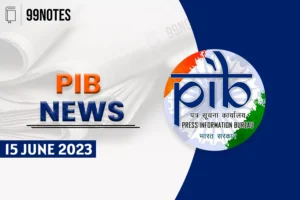10 June 2023 : Indian Express
Indian Express
- Indian Express
- 1. El Nino returns after 7 years, June arrival is likely to impact the second half of the Monsoon
- El Nino
- La Nina
- Indian Context
- 2. No need for universal Basic Income; it brings perverse incentives: CEA
- Universal Basic Income
- Arguments in favour of UBI
- Conclusion
- 3. ISRO to launch Chandrayaan-3 by mid-July: Somanath
- Chandrayaan – 2 Mission
- 4. New flare-up in Manipur: 3 shot dead in Kuki village
- The Way Out
- 5. MSP hike and its impact
- Significance
- What is MSP?
- Why do we need MSP?
- CRISIL
- Non Uniformity in Procurement
- Challenges in MSP Decision
- Decision Taken
- Impact on Treasury
- Impact on Rural India
- For Enquiry
10-June-2023
The Indian Express, CSE candidates can stay informed about current events and developments in India and around the world.
1. El Nino returns after 7 years, June arrival is likely to impact the second half of the Monsoon
Syllabus – GS I
Recent Context: The National Oceanic and Atmospheric Administration (NOAA) of the United States federal administration announced the back of El Nino after Seven years. Though expected, this confirmation by NOAA is of significant concern to India.
El Nino
-
El Nino, which means little boy in Spanish, refers to an abnormal warming of the sea surface waters in the equatorial Pacific Ocean that influences global weather events. Over India, the El Nino results in suppressed rainfall during the monsoon season.
-
The sea surface waters in the Pacific Ocean alternate between a warm and cold phase every two to seven years, with a neutral phase thrown in between. This fluctuating system is called El Nino Southern Oscillation, or ENSO.
-
During ENSO neutral conditions, the trade winds blow west along the equator and take the warm water from South America towards Asia. Whereas, during an event of El Nino, these trade winds weaken and instead reach the coasts of western America.
La Nina
-
The cold phase, or La Nina, usually has opposite impacts compared to El Nino.
-
During La Niña events, trade winds are stronger than usual, pushing warmer water toward Asia. Upwelling increases off the west coast of the Americas, bringing cold, nutrient-rich water to the surface.
Indian Context
In India, there have been 18 drought years over 100 years. Of these, 13 years were associated with El Nino. Between 1900 and 1950, there were 7 El Nino years, but in 1951-2021, there were 15 El Nino years. Of these, nine summer monsoon seasons recorded deficient rain.
2. No need for universal Basic Income; it brings perverse incentives: CEA
Syllabus – GS II, GS III
Universal Basic Income
It is a programme for providing all citizens of a geographic area (a country or State) with sum of money, regardless of their income, resources or employment status.
-
The main idea behind UBI is to reduce poverty and increase equality among all.
-
The essential principle behind UBI is the idea that all citizens are entitled to a livable income, irrespective of the circumstances.
UBI has the following important components:
-
Universality (all citizens included).
-
Unconditionality (no prior condition).
-
Periodic (Payments at regular periodic intervals).
-
Payments in cash (not food vouchers or service coupons)
Arguments in favour of UBI
1. Provide secured income to individuals.
2. Reduce poverty and income inequality in society.
3. Increase the purchasing power of every poor, further increasing aggregate demand.
4. Easy to implement because no identification of the beneficiary is involved.
5. Reduce the wastage of government money because its implementation is very simple.
Arguments against UBI
1. Lack of political will because of the costs involved.
2. Difficulty in reducing some of the existing subsidies to balance the resulting deficit.
3. Stress on the banking system
4. Reduction in labour supply
5. Exposure to market risk
Conclusion
The 2017 Economic Survey had flagged the UBI scheme as “a conceptually appealing idea”. So it can be a possible alternative to social welfare programmes targeted at reducing poverty.
3. ISRO to launch Chandrayaan-3 by mid-July: Somanath
Syllabus – GS III
Recent context – ISRO will begin a fresh bid to land a rover on the moon in the middle of July this year through the launch of the Chandrayaan-3 mission.
-
The Chandrayaan-3 mission is identical to the Chandrayaan-2 mission, which failed in the final stage of its launch.
-
The satellite has moved from UR Rao Satellite Centre (Bengaluru) to the Satish Dhawan Space Centre (Sriharikota). The rocket is LVM (Launch Vehicle Mark)-3, and its integration is ongoing.
-
ISRO has developed a new test facility for its semi-cryogenic engine, which is under development.
Chandrayaan – 2 Mission
-
Chandrayaan-2 is a sequel to Chandrayaan-1, an Orbiter mission launched in October 2008.
-
It comprised an Orbiter of the Moon, Vikram the lander and Pragyan the rover, all equipped with scientific instruments to study the moon.
-
Despite the failure, the mission’s orbiter and other parts have been gathering information.
-
Information gathered from Chandrayaan-2 – the presence of water molecules on the moon, the Presence of Minor elements like chromium, manganese and Sodium and information about solar flares.
4. New flare-up in Manipur: 3 shot dead in Kuki village
Syllabus – GS III
Recent Context – Violence in Manipur
-
Violence in Manipur has much to do with its geography and ethnic communities. The issue is related to the non-tribal Meitei community and the Kuki community. The ethnic violence has its root in a 10-year-old demand for an ST tag for the Meitei community.
-
The Imphal Valley is in the middle of the State, surrounded by hills.
-
The non-tribal Meitei, who make up more than 64% of the State’s population and produce 40 of the State’s 60 MLAs, are the dominant ethnic group in the valley, which makes up roughly 10% of Manipur’s landmass.
-
While the majority of Meiteis are Hindus, followed by Muslims, the bulk of the 33 acknowledged tribes-generally categorized as “Any Naga tribes” and “Any Kuki tribes”-are Christians.
The Way Out
-
This key issue has to be handled carefully by the government. The best policy is to carefully and seriously manage these apprehensions and looming misunderstandings among the people.
5. MSP hike and its impact
Syllabus – GS III
Recent Context – The Government has recently announced MSP for 17 crops of Kharif’s Season.
Significance
MSP plays a significant role for farmers of India as well as for the consumers.
What is MSP?
MSPs are support prices announced by the Government. The intended aim is to provide a safety net for farmers.
Why do we need MSP?
-
Uncertainty of the harvest
-
The lack of warehousing and cold storage in India leads to limited bargaining power for farmers.
-
The Government announces MSPs for 22 mandated crops and fair and remunerative prices (FRP) for sugarcane. The mandated crops are 14 kharif season crops, 6 rabi crops and two other commercial crops. In addition, the MSPs of toria and de-husked coconut are fixed based on the MSPs of rapeseed/mustard and copra, respectively.
-
According to a CRISIL research report, crops such as paddy, cotton and, to a limited extent, pulses get procured at MSP. Only few Kharif crops benefit from government procurement.
CRISIL
-
It is an Indian consulting firm offering ratings, analysis, risk and policy advice, and it is a branch of S&P Global, an American corporation.
-
It was India’s first credit rating body, founded in 1988 by ICICI & UTI by the incoming share capital of SBI, LIC and United India Insurance Company.
-
In April 2005, US–based credit score firm S&P bought most of the company’s shares.
Non Uniformity in Procurement
-
Around 45% of the paddy produced is produced at MSP, which is about 25% in the case of cotton and only 1-3% in the case of pulses.
-
Concentrated only in a few states.
States Crop
-
Punjab, Haryana, western Uttar Pradesh, Chhattisgarh and Telangana
Paddy
Telangana and Maharashtra
Cotton
Maharashtra and Karnataka
Pulses
Challenges in MSP Decision
-
Election’s influence
-
A rise in MSPs can lead to a spike in food inflation
-
The trade-off between the interest of the farmers and the consumers
Decision Taken
-
MSPs for the Kharif season will increase by an average of 7%.
-
Depending on the crop, the actual range is between 5% to 10.5%.
Impact on Treasury
Higher MSPs, more procurement, and the storage and disbursal of subsidised food grains are all expenditures that weigh down the Government’s financial health.
Impact on Rural India
The 7% MSP increase might just be enough to cover the increase in the cost of production but does not signal a pre-election populist boost to rural consumption.
For Enquiry

10 June 2023 : Indian Express

15 June 2023 : PIB

15 June 2023 : The Hindu Editorial

15 June 2023 : Daily Current Affairs

14 June 2023 : PIB

14 June 2023 : The Hindu Editorial

14 June 2023 : Daily Current Affairs

13 June 2023 : PIB

13 June 2023 : The Hindu Editorial

13 June 2023 : Daily Current Affairs
Indian Express 10 June 2023 : Indian Express Indian Express
10-June-2023
The Indian Express, CSE candidates can stay informed about current events…
PIB 15 June 2023 : PIB PRESS INFORMATION BUREAU
15-June-2023
Daily Current Affairs For UPSC ,The PIB ( Press Information Bureau…
The Hindu 15 June 2023 : The Hindu Editorial The Hindu Editorial
15-June-2023
Daily Current Affairs For UPSC ,The Hindu Editorial Summary
Facebook-f
Twitter
Youtube
1….
Daily Current Affairs 15 June 2023 : Daily Current Affairs DAILY CURRENT AFFAIRS
15-June-2023
Daily Current Affairs For UPSC ,Daily Current affairs of The hIndu…
PIB 14 June 2023 : PIB PRESS INFORMATION BUREAU
14-June-2023
Daily Current Affairs For UPSC ,The PIB ( Press Information Bureau…
The Hindu 14 June 2023 : The Hindu Editorial The Hindu Editorial
14-June-2023
Daily Current Affairs For UPSC ,The Hindu Editorial Summary
Facebook-f
Twitter
Youtube
1….
Daily Current Affairs 14 June 2023 : Daily Current Affairs DAILY CURRENT AFFAIRS
14-June-2023
Daily Current Affairs For UPSC ,Daily Current affairs of The hIndu…
PIB 13 June 2023 : PIB PRESS INFORMATION BUREAU
13-June-2023
Daily Current Affairs For UPSC ,The PIB ( Press Information Bureau…
The Hindu 13 June 2023 : The Hindu Editorial The Hindu Editorial
13-June-2023
Daily Current Affairs For UPSC ,The Hindu Editorial Summary
Facebook-f
Twitter
Youtube
1….
Daily Current Affairs 13 June 2023 : Daily Current Affairs DAILY CURRENT AFFAIRS
13-June-2023
Daily Current Affairs For UPSC ,Daily Current affairs of The hIndu…

